Many people go their whole lives and never hear about voles, but if you have a vole infestation, you know that these little rodents are no minor issue.
The good news is I have a lot of experience exterminating voles. In this guide, I’m going to share tried and true vole control techniques. By the end of this guide, you’ll know exactly how to get rid of voles for good!
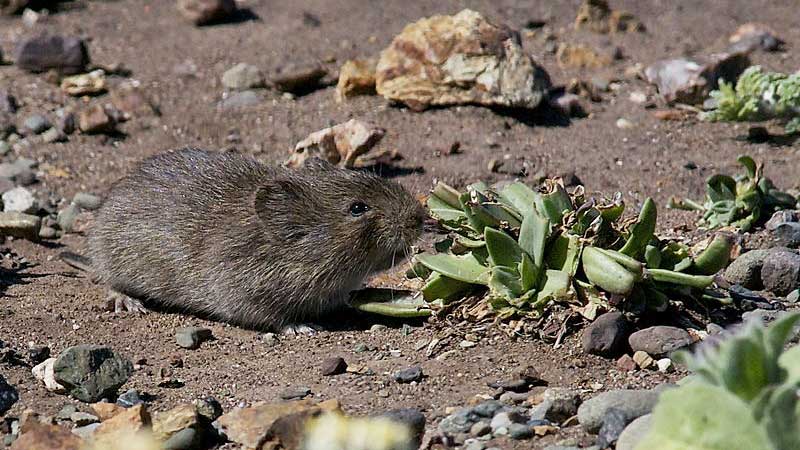
So what is a vole anyway? Voles have stout bodies and tiny legs, dark-colored fur, and round heads. When they grow up into mature garden-sacking pests, they generally average five inches long, including the tail. Some voles can grow to seven inches in length, although these are basically the Shaquille O’Neals of the vole world.
“Vole” sounds a lot like “mole,” but they are actually close relatives of the mouse. As you will notice in the pictures, voles are basically the cutest, chubbiest little mice imaginable. You almost want to let them consume your favorite plants, almost.
Voles can eat an amount of food nearly equal to their own body weight. This is bad news for your garden, as they will waste no time devouring a good many of your plants. Some more bad news: Voles don’t hibernate, so they’re active in all seasons. They prefer to wreck your garden at night, so rather than seeing them, you’ll probably just wake up to a lovely surprise in your backyard. Everyone loves surprises.
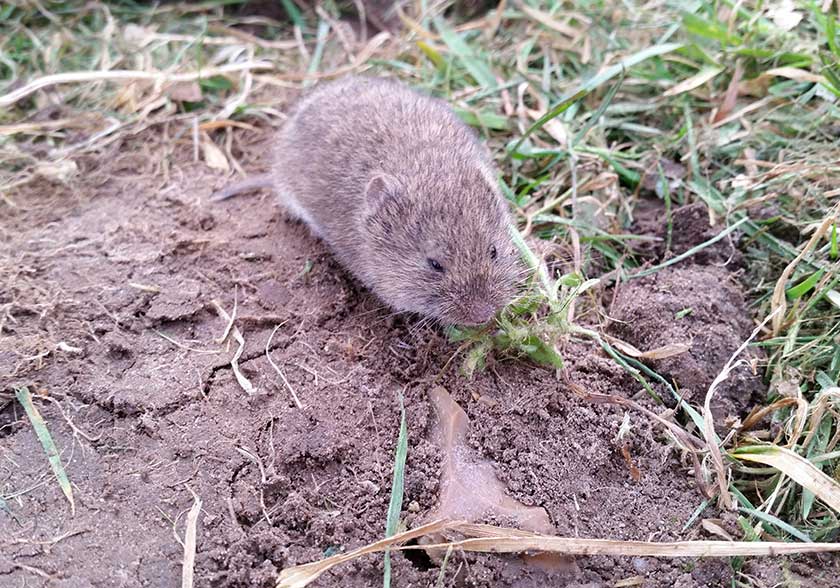
Sometimes known as “field mice” or “meadow mice,” the so-called “meadow vole” is the most common species. If you have a vole infestation, chances are you’re dealing with the main species.
Here Are the Best Ways to Get Rid of Volesv – Updated to 2023
Sometimes, preventing can only do so much. Unfortunately, circumstances can spin out of control. What if it is too late to prevent a vole infestation? If your property is already showing and feeling the damage caused by these little rodents, you might need to consider vole eradication. The sooner you act, the better–voles can easily do a lot of damage to your property in a short time. They can be humanely removed from a yard by using live traps, exterminated by using mouse traps/poisons, or barred from entry by garden fencing and vole repellents. Here is our favorite list of products for getting rid of vole infestations!
1. Our top choice for the second year in a row : Vole Snap Trap
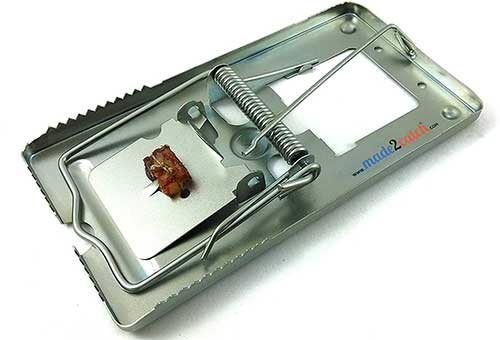
This is a Made2Catch classic metal rat snap trap. It is galvanized and can be reused. A rat trap is a better option than a mousetrap for voles because they can grow larger than mice. Most bates that work for rats will also work with voles including peanut butter and cheese.
Mole and vole can tunnel to get to the trap. Some users place a bucket or bin over the trap to not catch or injure other animals accidentally.
2. CaptSure Upgraded Humane Smart Live Vole Trap
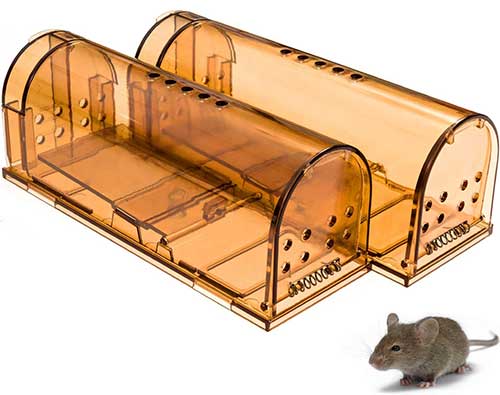
CaptSure Humane Smart Trap is a way to catch voles in a live trap. If you cringe at the idea of killing animals, even if they’re literally eating away your garden day by day, this trap might be worth a try. This product would be best suited to folks with the time and interest in releasing voles into safe environments away from the infested property.
This vole trap is also a great option for pet owners or parents who are worried about the safety of little ones in the yard. This trap comes in two sizes to accommodate any spatial needs and, it works equally well indoors and out.
It usually isn’t too much trouble to place these traps conveniently. They are pet-friendly, kid-friendly, and they do a stand-up job capturing voles in the most humane possible way. The trap has an easy setup, allowing it to be as close to a universal design as possible.
The see-through material is definitely a plus, enabling a clear view of captured voles. If you think you’ll have trouble seeing clearly through some of the colors they offer, we recommend getting the amber-colored trap–this can help to increase visibility.
With a hygienic and safe design, this item poses zero risks of injured or trapped fingers while setting it up. The CaptSure trap process in itself is super easy to clean, but if you use nuts instead of peanut butter to lure voles in, the cleanup time will be substantially reduced.
Features include that it is cruelty-free, safe around pets and kids, easy setup, reusable and easy to clean, quality guarantee with 24/7 customer support
3. Havahart 1025 Live Vole Trap
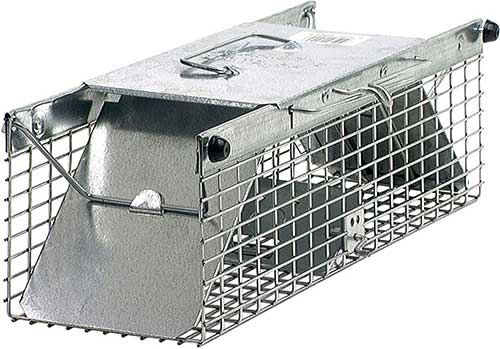
Havahart live traps are a popular way to catch rodents inclhttps://www.amazon.com/Havahart-1020-Animal-Two-Door-Mouse/dp/B0000DINGGuding voles. This is another great option if you have no interest in killing the poor little fellas. After all, they’re just rodents trying to make a living on the means streets of your lawn. This live trapping system is made from sturdy and reliable materials that will last a considerable amount of time should you need them again in the future. The Havahart 1020 can not only be used to eradicate voles, but to catch mice as well. The size makes for a double pest-control solution, providing two slots for vole containment.
You might be persuaded to buy this trap if you appreciate tradition. Havahart has been manufacturing the same design, and using the same materials, for over seventy years. For them, there’s nothing else to be changed design-wise, and they know that what they sell works.
Features include two gravity-action doors, smooth internal edges for the protection of the animals, and proven functionality through extensive field testing with high catch rates and few escapes. The live trap is made with a strong rust-resistant wire mesh with steel reinforcements galvanized for maximum resistance.
Related Article: 10 Best Rat Traps
4. Wire Tek 1001 EasySet Vole Eliminator Trap
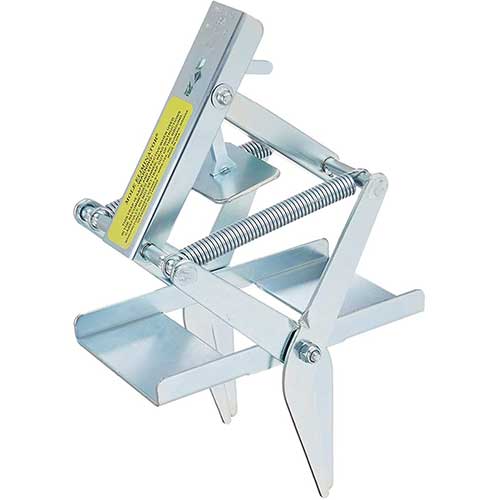
Wire Tek’s EasySet trap is best for gardeners or landscapers who have a small-to-medium vole problem and are looking for a DIY way to undertake a little extermination action. Purchasing the EasySet Vole Eliminator Trap will eliminate any need for poisons or chemicals on your lawn, making them a more environmentally friendly option–but a very unfriendly one to the voles.
This is the only trapping device on the market that can be set into the vole’s tunnel ridge without digging, setting dangerous spears, or clamps and cables. All you have to do is locate the center of the ridge and firmly insert the closed jaws until the base of the trap is leveled to the ground. Then step down on the setting lever to set the trigger mechanism. This trap is also accepted for use in organic farms, nurseries, and ranches.
Wire Tek’s EasySet trap is s a secure way to eliminate smaller vole infestations. Since its efficacy rate is 100% on exposure (doesn’t get much more efficacious than death), the time it will take to get rid of the voles is directly dependent on how often you check the traps and, of course, how many voles you have in the area.
Features include an easy foot stepping motion to set the trap safely underground, no need for chemicals or poisons, and are accepted in organic farms, nurseries, and ranches. Two traps come in this set.
Related Article: Best Mole Traps
5. Baar Lawn Vole Castor Oil
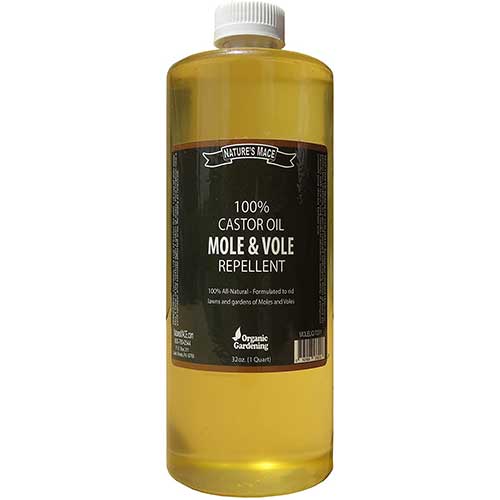
Castor oil can be used as a repellent for voles. So you like the idea of naturally repelling voles from your yard, but don’t want to have to plant more flowers than you already have. Or, simply put, you just want a good, cruelty-free solution that isn’t harmful to the environment or your garden. Enter Natures Mace mole and vole castor oil.
Depending on the size of your vole infestation, the time required to actually remove all of the rodents can vary. However, since this is a biodegradable product, you’ll most definitely have to reapply it over the infested property after its initial use. Some pests can be more stubborn than others, and voles can certainly get attached to their new housing on your land. But with Baar’s Vole Castor Oil, you can bet they’ll eventually leave. Of course, it should be noted that even though the product could be effective within days, you shouldn’t expect an instant solution.
For the best results, it is recommended that you apply the product once weekly. Once you’ve solved the issue, it’s a good practice to re-apply once every month to keep the voles from coming back. When using this type of repellent, it is important to consider the type of soil you have. For example, if your ground is of the dense, non-porous clay type, and you need the product to reach deeper than eight inches, you might be better off considering a different approach.
Features include simple and easy to use, environmentally safe, specifically designed to repel voles in a natural way, and it is safe for gardens, lawns, and pets. Castor oil is also effective for armadillos, moles, and gophers.
6. Repellex Vole Granular
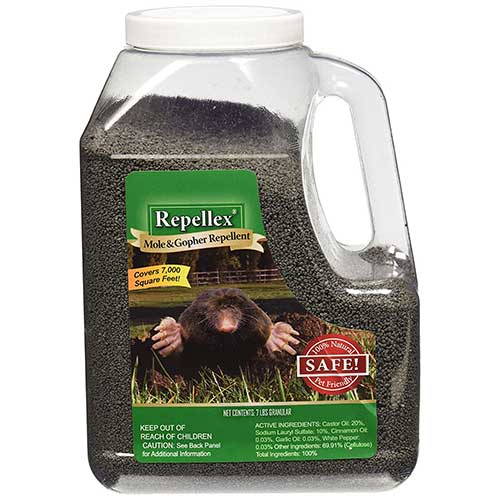
Repellex is a mole, gopher, and vole repellent. When burrowing pests like voles, moles, or gophers are causing major damage to your garden, it can seem like you have your work cut out for you. How are you supposed to deal with all those little beasts? You may be outnumbered, but with Repellex’s Vole Granular, you’re never outgunned. This is a product you might consider if you’re trying to stray from using harsh chemicals and poisons in your garden or lawn. Chemicals of that nature are often better suited to bigger plots of land. Repellex granular repellent is an entirely plant-based product that is effective in both keeping voles away and moving them off of your property.
It is good to take into consideration how much it rains in your area since the repellent will need to be applied more often in rainier climates. This is because Repellex’s product has a natural composition. Without rain, you only need to apply the pellets every two to three weeks.
The scent of this product will seem very strong when first applying it, which is exactly why voles hate it. While the detectable odor appears to fade after a couple of days, it actually keeps bothering the voles, gradually driving off your property.
This product could work quite well for those who live in rather dry areas, and whose gardens don’t grow pants meant to yield consumable vegetation. This product should not be used near plants that bear edible fruits or vegetables. Features include that it is all-natural, long-lasting, and easy to apply.
7. Bonide Molemax Vole Repellent Granules
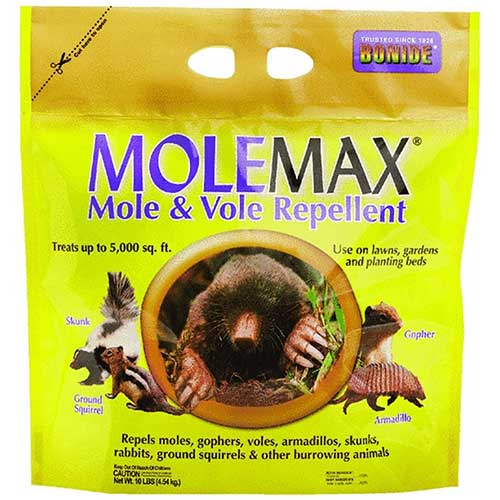
MoleMax is a great way to keep voles and other animals out of the garden. Its active ingredient is castor oil with acts as a natural vole repellent. This also helps keep rabbits, skunks, and gophers away from the garden.
It is best to spread this around the perimeter of the garden and within the garden. If it only used in one area the animals may just live in and eat plants that are far enough away to not bother them. This 10-pound bag can be spread out over 5,000 square feet and keeps rodents away for up to three months.
Toro Products Ultrasonic Vole Pest Repeller
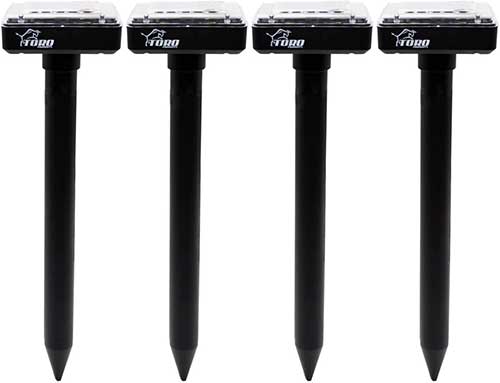
Ultrasonic Pest replies are often given as an option to repel insects and rodents. We do not recommend these products as most studies show they are not very effective. If you want to try it go ahead but it would be wise to use other methods in conjunction with an ultrasonic repeller.
These vole repellers have charging rates of 3 to 4 hours for 5 to 7 days of use, so you will get up to more than 7000 sq ft of coverage (650+ meters). Toro Products repeller reaches a total of 15.3 inches in height, making it the longest vole repeller available, entering the ground at a deep level. This so that the ultrasonic pulses can enter the soil to create vibrations and sonic waves that might chase away voles and other pests such as snakes, gophers, moles, and scorpions. If it did work this would be great as harmful poisons and chemicals would not be needed around your land.
Related Article: Do Ultrasonic Pest Repellers Work
What to Expect from a Vole Infestation
Voles are not exactly the toughest varmints around, so they love to frequent spaces that give them cover from predators, like brush piles, snow cover, and low-hanging tree limbs. Pastures, orchards, and any sort of plains with tall grass are common vole habitats. If your garden has tall plant life of any kind, it will look like a five-star hotel to nearby voles.
If they need to, voles can subsist on a series of second-rate dietary options, like dead animals, fruits, and nuts. However, if you really want to get a vole excited, you show him a nice big patch of succulent plants with heavy root systems. When voles access your garden, they will often consume these as well as plant life with underground bulbs. They are talented burrowers–while you are waltzing about your garden totally clueless, sneaky voles will gnaw your plants to death under the soil.
Unfortunately, the first indicator of a large vole presence in your garden is usually a bunch of dead plants. At that point, you want to pay special attention to the volume of devoured plantlife, as this will indicate the size of the vole problem. A couple of dead plants here and there is not so bad, but bonafide plant genocide is one clue that you have an army of adorable little voles infesting your property. The size of your vole infestation will inform your choice in anti-vole products, so take careful note here of just how many plants have been eaten from underneath.
How Do I Know if I Have a Vole Infestation?
You might have a little trouble identifying voles from other small animals like moles, mice, rats, gophers, and even shrews. They all act like a bunch of dirty rats, truth be told–getting into your food, plants, or other resources, and wreaking havoc. For identification purposes, here is a quick list of signs to help you sniff out a vole infestation. Not that we recommend sniffing voles, but you know what we mean.
Vole Activity
- Voles are especially active during the springtime. They’ll dig shallow snake-like tunnels that you’ll see all over your lawn, not totally unlike mole tunnels. Vole tunnels are smaller, averaging about two inches wide. The tunnels are usually dug very near the surface in order to gain access to food sources like grass.
- Mole tunnels are more like networks with secondary runways appearing on the surface of the lawn. A clear distinction between signs of moles and voles (for crying out loud, who named these things?) is a mole tunnel’s raised ridges. Many mole tunnels feature volcano-shaped mounds at intersections or points of termination.
- Voles leave no mounds behind, making them more difficult to detect. No one can miss a volcano.
- Another way to investigate a potential vole presence is to take a close look at the damages incurred to the plantlife. Voles are voracious plant eaters, more so than most of their rodent relations. If you find your potatoes partially eaten, carrots gnawed, or other root vegetables otherwise snacked upon, you can pop voles to the top of your suspect list.
- Voles eat flower bulbs from below the ground primarily because these are near the surface. If you spot chewed-up bark near the base of any shrubs or trees, pay attention to the dimensions. A vole’s front teeth leave quarter-inch twin grooves in the wood, which would be cute if it were not so ominous.
- Voles can tunnel through any root system, causing damage to the plants. If you see young trees or shrubs that lean more than they probably should, you could be looking at a vole infestation.
Vole Invasions: Preventing an Infestation
Instead of waiting until you have a real vole infestation, you are probably better off taking preventative measures. As they say, the best offense is a good defense–at least, this is what you will be shouting as you prep your garden’s defenses, just in case any nearby voles are listening and also understand a bit of English.
Make sure you cover all of our “do’s and don’ts” for keeping these little fellas at bay. Adequately prepping your yard can make the difference between the garden equivalent of Mad Max, and prize-winning veggies that will make Mom & Pop proud. These aren’t all intensive or unusual tasks either; forestalling a vole invasion can be as easy as cutting your lawn regularly. Check out our suggested practices below. That is, before you wind up having to actually get rid of a vole infestation
Voles and Lawncare
- The length of your lawn is crucial. As fall ends, cut it short before the snow arrives. You don’t want to provide voles with a comfy tall-grass environment. Keeping the lawn freshly cut eliminates potential hiding places as well as food sources.
- Watch the ground covers. Avoid planting dense ones like creeping junipers. This goes hand in hand with keeping your lawn mowed and weeded.
- Beware of compost. Unless you do your composting during winter, make sure the compost bin is sealed tightly by the end of autumn. To voles, compost bins are pretty much an all-inclusive luxury resort. With tiny casinos.
- Guard your young trees. During winter, voles like to chew on young trees. This causes significant damage and sometimes even root girdling. You can protect the trees with plastic or wire tree guards, but always be mindful not to damage roots when setting these up. Once the trees mature they will no longer be quite so attractive to voles.
- Wait on the mulching. A deep layer of much can be very encouraging to voles. Should you need to protect tender plants by mulching them, wait until immediately after the ground has frozen. This way, voles can’t get their little claws into the turf. Do it too early and you’ll be providing a comfortable place for voles to hunker down during the chilliest season.
- Keep snow cleared away from shrubs and young trees. Voles will use snow as cover in order to attack your landscaping with sneaky efficiency. If you have a cat or dog handy, allow them to play around in the yard. Voles may feel threatened by these large beasts and forget about your yard altogether, moving onto safer pastures.
Safely Disposing of Dead Voles
If you’re using a trap that kills the pests on the spot, it is crucial that you are well versed in how to dispose of the carcass. Voles, just like mice and rats, can be the carriers of various diseases, so if you’re not sure of how to throw away the animal’s remains, there are a few simple steps you can follow:
- Depending on the type of trap you’re using, you should release the corpse from it without directly contacting it. Wear gloves for the best protection
- Use a shovel to carry the animal and put it into a plastic bag. Tie a knot on the bag and place the animal into a second bag
- Dispose of the bag in an outdoor trash container
- Wash hands thoroughly
Relocating Live Trapped Voles
If your vole-removal tactics utilize live trapping systems, it will naturally fall to you to properly relocate them into a safe environment where they’ll be far away from your garden and plants. If this is your first time dealing with a vole infestation and you are not sure of how to release them, we have a simple guide just below. All it takes is a little extra consideration to help voles survive in their new environment.
- Determine whether the vole is female and if it’s nursing. If it is, it’s more likely that it will return for its babies. If possible, try to relocate the family as a whole. You can tell whether a female vole is nursing by its protuberant nipples, which you won’t be able to see otherwise
- Relocate the vole as soon as possible. If you can’t do so immediately, avoid handling it.
- If the temperatures are extremely cold, wait for better conditions.
- In order to minimize the chances that the vole will not return, release it about two-to-three miles from your property
- Try to find a location apart from human habitation where the voles can find some shelter like rocks, a pile of wood, or a series of branches.
- If you can’t find good shelter for them, make sure that you at least set them free in an area with some low ground cover. This will help them avoid predators and build a proper nest.
- Once you release the voles, you can leave some food for them like seeds, peanuts, or even dry cat or dog food, as well as some nesting materials like a few torn up paper towels. This is important for cold-weather releases.
Vole Repelling Plants
Our above prevention guide is step one to avoiding vole infestations. If you want to make sure you’re doing everything in your power keep those chubby little jerks off your property, you’ll want to familiarize yourself with plants that naturally repel voles. These beauties are all great options for filling yards or gardens with attractive plants. Plants that will not cry out to voles like a second helping of dark meat cries out to us on Thanksgiving. Here are six natural plants with vole-repelling power.
Lenten rose (Helleborus orientalis)
The lenten rose is a hardy flower that blooms toward the beginning of spring. Importantly, voles do not eat it! The lenten rose has leaves of glossy evergreen and generally tough components that are rather discouraging to voles. Fortunately, it’s also one of the easiest plants on our list to grow. It looks nice and it’s an iron-tough customer among floral options. And you thought flowers were dainty.
Trout lily (Erythronium americanum)
Maybe lesser known plants spark your childlike curiosity. Maybe you’re a garden hipster and you don’t want to fill your garden with things that everyone seems to be growing. Personally, we liked roses before they were mainstream. If you’re like us, you might consider the trout lily. This is a North-American native plant with vole-resistant properties. Under the right conditions, it can really blossom and show off its graceful yellow flower every year.
Castor bean plant (Ricinus communis)
Remember Breaking Bad? This is the mean green plant from which certain criminal chemists derive the extremely poisonous ricin substance. It can become problematic if you have children playing in the yard, so this isn’t one for families or yard owners with pets. But a vole takes one bite of these bad boys and you can guess what happens. They probably won’t though, as the plant itself will usually discourage them from remaining in the area.
Salvia
Answering your first question, no, voles will not get a weird 15-minute salvia high from this plant. Salvia stinks, so voles won’t eat it==pretty straightforward. The types of salvia range from perennial to annual. Many people have heard about the red annual kind, but if you opt for the perennials, you have various types to choose from: Victoria Blue (S. farinacea Victoria Blue), May Night (S. nemorosa May Night), Caradonna (S. nemorosa Caradonna), or Blue Hill (S. nemorosa Blue Hill).
Jack-in-the-Pulpit (Arisaema triphyllum)
This is another plant that voles avoid, often found growing on the forest floor of its native habitat in North America. Jack-in-the-Pulpit is a great foliage plant for spring and summer, also bearing bright-colored berries in fall. As a late-night snack, it is not as gratifying as Jack-in-the-Box, especially that Ultimate Cheeseburger with extra ketchup.
Daffodils (Narcissus)
If you have a woodland garden there are few flowers better suited to them than daffodils. As they are poisonous plants, voles are repelled by them. And they’re super easy to grow! They bloom in spring, which means that they can get the full sun they need by growing under a deciduous tree.
Conclusion About Voles
That wraps up our guide to taming your lawn od garden’s unwanted vole population! New products are constantly being researched finding their way to the market, so we make efforts to update our lists with all the latest practices and products available. If you notice we have missed anything, please don’t hesitate to mention it in the comments.
We also love talking about DIY home remedies, so if you’re a creative chemist or a purpose-built gardener, let us know what concoctions have worked for you! Good luck out there, pest removers.
Related Article: 14 Best Ways to Get Rid of Mice
My name is Blane and I’m a life-long resident of Southeastern Louisiana. I’ve been working as Pest Control Technician and Inspector for about 1.5 years now.
I’ve worked in many other industries as well, including consulting, managing, as well as at the ground level in fields including Food Service, Corporate Automotive sales, and finance. Whether it be providing counsel, content, or hands-on support; my goal remains to add value to the lives of the people I serve.
If you have any questions regarding pest control, leave them below. I would be happy to help you out in any way I can.

Here’s a crazy question we have 2 large oak trees that we have iron plants around each one of them. They are steadily disappearing. You can see where they are getting pulled underground. My wife and I have actually seen the plant being under. You can hear them eating it also, sounds like someone chewing celery. They have completely eaten all the plants around one of the oaks and started on the other one. The weird thing is there are not any signs of them in the yard. You can find some tunnels in the middle of the plants but again no sign of where they come from. How would they be getting in under the plants? You can’t trap them because you can’t find any tunnels leading up to the trees. The only way I found tunnels in the plants is it rained and you can see where the water went through the tunnel and opened it up. We bought the solar-powered steaks that vibrate and make a sound every 20 seconds but that’s not working. Any ideas on what I can do?
I heard that processed potato flakes will attract them but expand in their stomachs. Ouch! You guessed it. Is this true?
Do the bucket drop swivel lid-type traps work with voles? I know the bucket type doesn’t work for rats, as rats detect the movement and react.
Are traps better than poison for eliminating voles? They are taking the poison, but still not eliminated. Please advise. thanks